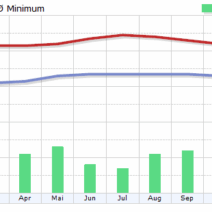In a world increasingly fraught with environmental crises, the Climate Clock serves as a poignant reminder of the pressing issues surrounding climate change. Displayed prominently in various urban spaces, this innovative countdown mechanism acts as a digital consciousness, urging global citizens to recognize the urgency of their collective responsibility towards the planet. The most notable instance of the Climate Clock is located in New York City, although numerous adaptations and installations have emerged across the globe, each resonating with the same intention: to visualize our time left to mitigate the detrimental effects of climate change.
New York City’s Climate Clock, situated at the Astor Place in Manhattan, has captured the attention of passersby since its debut. Towering over the bustling streets, this large, illuminated clock not only serves as a timepiece but also as an educational tool. It provides a stark visual representation of the remaining time to lower global temperatures to a manageable level, specifically aiming to adhere to the goals set forth by the Paris Agreement. This agreement, ratified by numerous nations, seeks to limit global warming to well below 2 degrees Celsius compared to pre-industrial levels, ideally aiming for a cap of 1.5 degrees Celsius.
But what underpins the fascination with this digital clock? The attraction is multifaceted. At its core, the Climate Clock encapsulates the urgency of now. It imparts a sense of immediacy: in a society often immersed in distractions, the clock presents a tangible, quantifiable deadline for substantial action on climate change. The countdown challenge urges individuals and communities alike to reconcile their daily choices with an overarching purpose. In seeing the numbers decrease, an implicit narrative forms: urgency breeds responsibility.
The clock itself operates on a simplistic yet profound premise. It conveys a message derived from climate science, translating intricate climate models and predictions into an accessible format. In a world overwhelmed by data, such visual representations break down complex statistics into digestible elements that provoke thought, conversation, and action. Visitors to the installation often find themselves reflecting on what a ticking clock signifies; time lost is synonymous with opportunities missed. It invites individuals to consider their role in either hastening or hindering climate progress.
Beyond New York City, similar installations have emerged across continents, dotted through urban landscapes that share a common struggle against climate change. From Berlin to San Francisco, these clocks draw attention to local and global climate issues, tailoring the message to fit diverse cultural contexts. The proliferation of these Climate Clocks symbolizes an emergent global consciousness—cities, which are often epicenters for carbon emissions, are confronting their impacts through digital awareness.
The geographical placements of these clocks tell an intriguing story of environmental activism. Urban centers, often characterized by high-density living and industrial activities, emerge as focal points where the stakes of climate change are palpable. Citizens in these locales are regularly reminded, literally, of the cost of apathy. The notion of an environmental deadline becomes more pressing when one can visually and publically engage with it.
But let’s delve deeper into the community aspect illuminated by these clocks. Each Climate Clock installation serves as a catalyst for dialogue, inspiring impromptu discussions about sustainability and climate action among individuals from different walks of life. The aesthetic appeal of these installations—often designed with vibrant colors and engaging artwork—further draws in local populations, laying the groundwork for education and, ultimately, mobilization for environmental causes.
The fascination with the Climate Clock also parallels with an evolving understanding of climate change itself. As scientific discourse matures, so too does public comprehension. The stark visual of a countdown ignites urgency in ways that abstract graphs and complex terminology often fail to achieve. Indeed, it serves as a call to arms, engendering a civic culture of awareness and advocacy. Citizens are encouraged not only to watch the clock tick down but to actively participate in shaping policy and behavior that can positively influence environmental outcomes.
The community involvement surrounding these clocks further embodies transformation. Grassroots movements flourished, frequently using the presence of a Climate Clock to enhance their messaging. Various organizations coordinate events to coincide with these installations, fostering community engagement and enabling local citizens to take ownership of their environmental impact. The clock, then, becomes a symbol of collective empowerment, reminding people that their actions matter, and that the power to change the trajectory of climate mismanagement lies in their hands.
In conclusion, the Climate Clock represents more than just a countdown to a potential environmental crisis; it embodies a societal awakening to climate realities. Its location in New York City stands as a poignant reminder of our shared location on this planet—indeed, we all exist under the same ticking clock. While hours and minutes swiftly fade, the action prompted by such reminders can define the next epoch of human interaction with the environment. As the world grapples with solutions, the Climate Clock serves not only as a factual tool but as a beacon of commitment towards nurturing a sustainable future.








